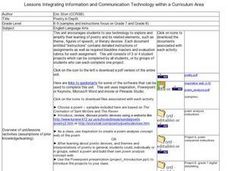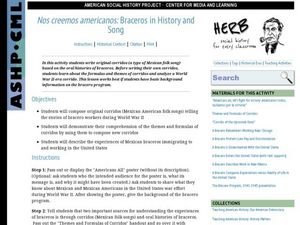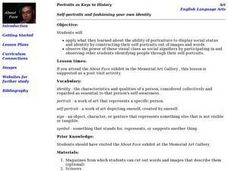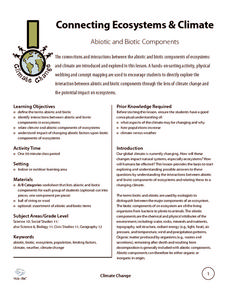Curated OER
What's In a Phrase? Finding Historical Understandings in an Immigrant Guidebook
Using a Chinese-English phrase book from the late 19th century, learners view a glimpse of life on the frontier for a Chinese immigrant. They work in groups and on their own to analyze and summarize the content of various phrases, given...
Curated OER
Inventions in Everyday Life
Students identify and solve problems as they modify the design of an everyday household item. They gather and analyze information and work in collaborative teams to create a design plan for a new product.
Curated OER
Poetry in Depth
Scholars use technology to explore poetry and its related elements, such as theme, figures of speech, and other literary devices. They complete four poetry projects including a poem analysis with a concept web, an interactive poem...
Curated OER
Soccer Football
Games like this are so much fun! It's basically a big keep-away game, but you get to score points. There are rules by which to play, so students can practice the passing and catching skills in football as much as possible in the game....
Curated OER
The Poetry of Chinese Immigration
Numerous people from China immigrated to the US during the era of industrialization and expansion. Provide your class with a glimpse into the life of a Chinese immigrant through the poetry they left behind. They then compose a poem of...
Curated OER
Nos Creemos Americanos: Braceros in History and Song
Mexican folk songs offer an authentic look at WWII immigrant workers. This study of the U.S. Bracero Program sets historians up with context information so they can write their own corrido. The class reviews themes and formulas of...
University of Colorado
The Jovian Basketball Hoop
Can you listen to Jupiter on a simple radio? Turns out the answer is yes! The resource instructs scholars to build a simple radio to pick up the radio waves created when the charged particles from the sun hit Jupiter's magnetic...
Ohio Literacy Resource Center
Compare & Contrast Essay
Comparing two texts can build a greater understanding of the texts and themes of the works. Take some time to follow the steps here to guide your pupils through the process of composing compare-and-contrast essays.
Curated OER
Lesson Plan Outline for Rainbow Science
Young scientists study light reflection and refraction as they determine the critical angle, the rainbow angle, and color separation in rainbows. Teams record the data they collect in a shared spreadsheet and discuss results with the class.
Cornell University
Mechanical Properties of Gummy Worms
Learners won't have to squirm when asked the facts after completing an intriguing lab investigation! Hook young scholars on science by challenging them to verify Hooke's Law using a gummy worm. Measuring the length of the worm as they...
Curated OER
Pop Culture Icons: Medieval Music
Kids compare and contrast music from the past to the present. They listen to and review the characteristics of Medieval, Renaissance, Baroque, and Pop music. Then, they discuss the differences in each and how musical icons from the past...
Curated OER
Financial Institution Comparison
Once learners are ready to choose a bank, how do they make a smart decision for their financial needs? Scholars help each other by jigsawing the research in groups. After introducing checking and savings accounts with the attached...
Curated OER
Portraits as Keys to History
Students create self-portraits using images and words. They discuss portraits from the Memorial Art Gallery, create a self-portrait collage usng images and words from magazines, and complete a worksheet.
Curated OER
Picturing History: John Singleton Copley and British Portraiture
Students observe and compare 18th century British portraits with those made by John Singleton Copley. By conducting research they explore the cultural climate of the portraits in order to write a historically accurate story.
Curated OER
Using Punctuation Correctly
A PowerPoint presentation outlines the basic rules for correct comma usage. Viewers then edit texts for correct comma usage, identify which rules are being addressed, and complete worksheets as needed. The PowerPoint is included;...
Curated OER
Is That Movie OK?
Discuss movies and movie enjoyment with your middle school language arts class. They interpret movie review information, determine appropriate movies, and then write film reviews to share with the class. Focus on using context clues to...
Curated OER
Fashion Strategies
Discover fashion terms with your class, they will design details while examining the top designers and world fashion centers. Among the topics discussed are: marketing, specializing, and designer labeling. To complete the assignments,...
Ohio Department of Education
The Solution is Complex
Consider complex numbers, roots, and quadratic equations. Use the discriminate as a way to determine the nature of a quadratic's roots. Then discuss the similarities and differences between quadratics with two, one, or no real roots....
Curated OER
Dr. Jekyll and Mr. Hyde: The Cloze Procedure
Is your class prepared to read Dr. Jekyll and Mr. Hyde? Do they have the reading level necessary to truly comprehend the novel? Use the cloze procedure (detailed here) to determine if this text is appropriate for your class. The first...
Novelinks
Man's Search for Meaning: Anticipation Guide Instructions
To prepare readers for the major concepts in Victor Frankl's Man's Search for Meaning, an account of his life in Auschwitz, class members respond to a series of statements on an anticipation guide.
Curated OER
Decision Making Skills and Goal Setting
In need of a scripted lesson anyone can deliver? Along with a teaching script, you'll find several scenarios for learners to consider. They'll discuss decision making and goal setting as they relate to each scenario. Guiding...
Curated OER
Stem Cell Development
Like a fresh canvas, stem cells can turn into almost anything. In a comprehensive lesson, high school biologists use clay to build a 3-D model of cell division and the processes that occur during the first 14 days of development. Also...
Wild BC
Connecting Ecosystems & Climate
Collaborators sort a set of cards into biotic and abiotic categories. Then, as a class, they discuss their work and relate each of the abiotic components to climate change. Finally, they form a web of components by connecting those that...
Intel
What Does This Graph Tell You?
What can math say about natural phenomena? The fifth STEM lesson in this project-based learning series asks collaborative groups to choose a phenomenon of interest and design an experiment to simulate the phenomenon. After collecting...























